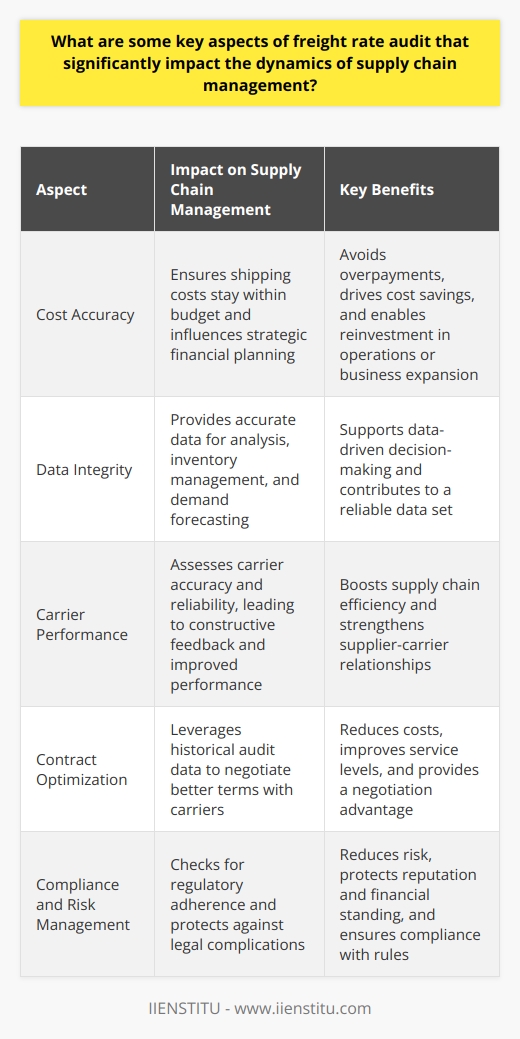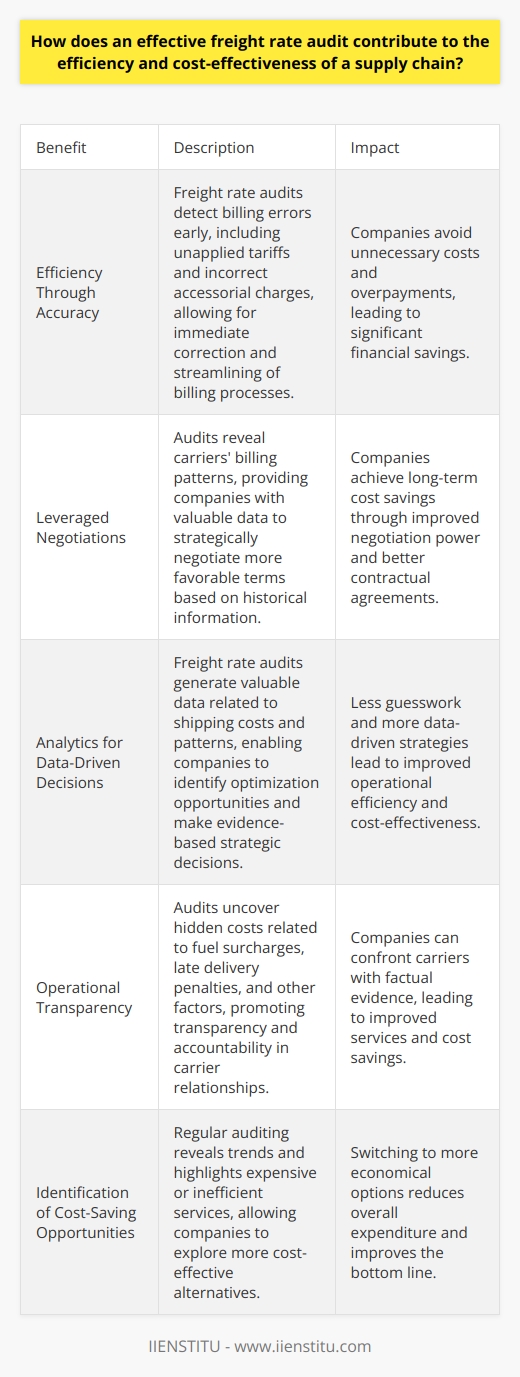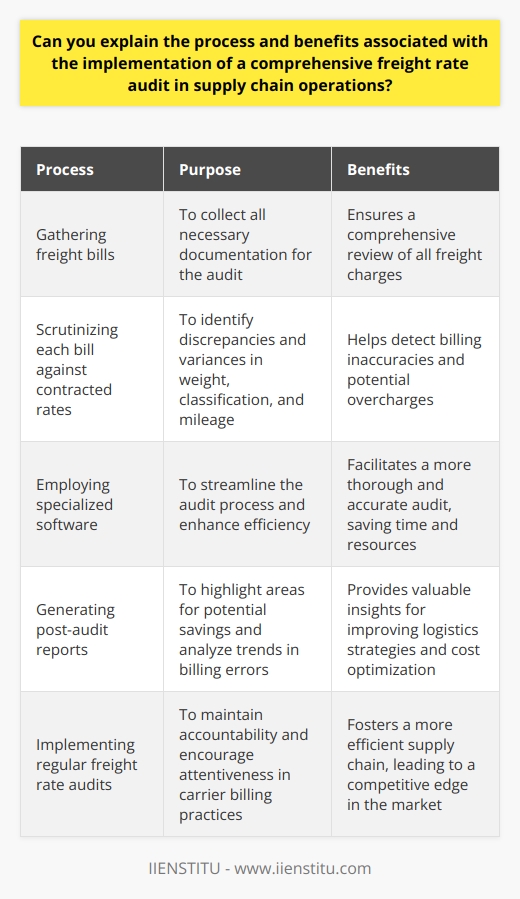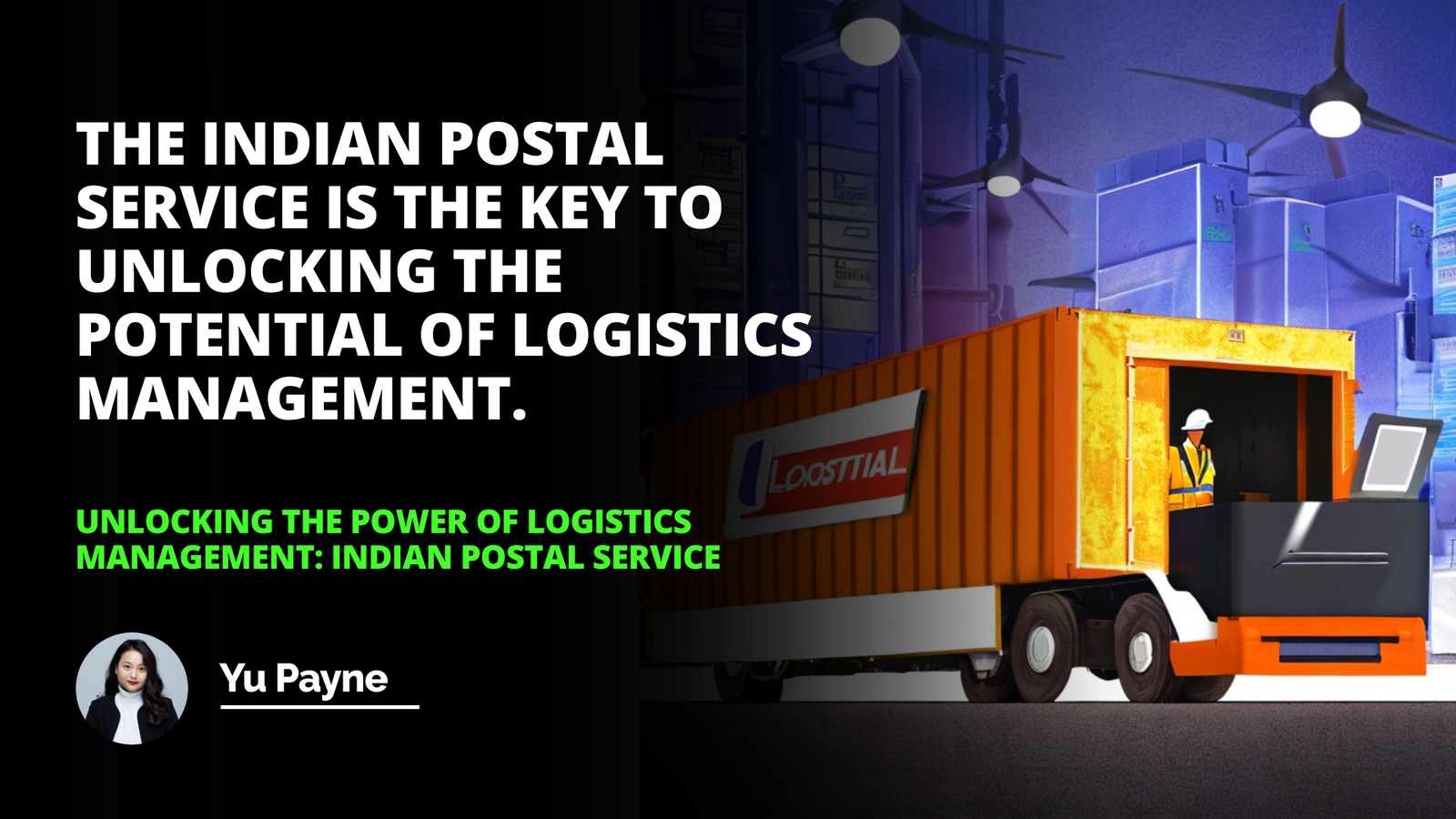
In a world increasingly governed by the complexity of logistics and the need for cost-effective supply chain management, understanding the finer details, such as freight rate audits, holds immense importance. Sophisticated supply chains require constant monitoring and optimization to ensure financial accountability and efficiency. Freight rate audits serve as a critical tool, offering transparency and control over the financial aspects of freight movements. By examining the intricacies of these audits, businesses can not only prevent overbilling and improve accuracy in their logistics but also stand to gain insights that could significantly bolster their operational dynamics.
I. Introduction
A. Brief introduction to Freight Rate Audit
In the intricate ecosystem of supply chain management, the meticulous process of a freight rate audit is often likened to a financial health check-up for logistics operations. It involves the scrupulous examination of shipping costs, agreements, and invoices to identify billing discrepancies and ensure contract compliance. Given the multitude of transactions and the complexity of freight rate structures, audits are essential to maintain financial transparency and prevent revenue leakages.
B. Importance of Freight Rate Audit in Supply Chain Management
Within the sphere of supply chain management, freight rate audits hold a position of paramount importance. They safeguard against overpaying, foster strong carrier relationships through transparent dealings, and enable businesses to reallocate funds that might have otherwise been lost to inaccuracies. With the potential to provide significant cost savings, effective auditing also instills confidence in financial reporting, ensuring operational decisions are based on accurate data.
II. Understanding Freight Rate Audit
A. Definition of Freight Rate Audit
A freight rate audit is an in-depth review process aimed at validating the accuracy of charged freight rates against the carrier’s agreed-upon tariff or contract. The focal point of this scrutiny lies in verifying that the rates, classifications, and additional accessorial charges applied to shipments are correct and consistent with the carrier agreement.
B. The purpose and advantages of conducting a Freight Rate Audit
The principal purpose of a freight rate audit is to ensure that charges reflect accurate and agreed-upon rates, weights, and service types. Advantages of conducting such systematic reviews extend beyond rectifying overcharges to include improved operational efficiencies, enhanced negotiation leverage with carriers, and the provision of valuable data analytics that can inform strategic decision-making.
III. The Process involved in Freight Rate Audit
A. Identification of discrepancies
Excessive charges often crop up from misapplied tariffs or human error in data entry. Without freight rate audits, these can go undetected, leading to unwarranted financial burdens for a company.
Incorrect freight class can result in inappropriate rate application, significantly impacting the freight costs. Accurate classification is vital for proper charge calculations.
Duplicate charges can also slip through the cracks of a busy logistics operation. Audits catch such redundancies and prevent paying for the same service multiple times.
B. Understanding the freight bills
Freight bills often contain complex information that requires knowledgeable analysis. Organizations need a thorough understanding of these documents to effectively review and audit them, ensuring that each component of the freight charge is legitimate and accurately calculated.
C. The role of freight audit providers
Freight audit providers are expert firms specializing in the meticulous review of freight bills. They bring experience and insights into industry best practices, ultimately enhancing the efficiency of the audit process.
D. Discussion on Freight invoice auditing software
The rise of freight invoice auditing software has significantly impacted the ability of companies to efficiently process and audit large volumes of invoices. Such technology vastly improves accuracy, speed, and reliability in audit outcomes.
IV. The Impact of Technology on Freight Rate Audits
A. Automation in Freight Rate Audits
The infusion of technology, particularly automation, has marked a before-and-after in the realm of freight rate audits. Automation software enables continuous, real-time auditing, minimizing human error while maximizing process efficiency.
B. Benefits of technological advancement in Freight Rate Audits
The benefits reaped from technological advancements in this domain are manifold. Enhanced data accuracy, faster processing times, and comprehensive reporting are but a few of the tangible perks that accompany the digitization and automation of freight rate audits.
V. Challenges faced during Freight Rate Audit
A. Complexity of freight rates
Freight rates are notoriously complex and subject to various factors such as distance, volume, and weight. This complexity can make audits particularly challenging as it requires a high level of familiarity with the tariff structures and industry standards.
B. Time-consuming nature of manual Freight Rate Audit
Manual freight rate audits are not only susceptible to human error but are also exceedingly time-consuming, often requiring substantial resource allocation and prolonged review periods.
C. The challenge of inaccuracies and discrepancies
Inaccuracies and discrepancies are the chief adversaries of supply chain financials. Identifying and rectifying these within freight bills demand incessant vigilance and a strategic approach to audit procedures.
D. Intricacy of freight audit and payment
The entire process of auditing and subsequently processing payment embodies its own set of intricacies. Ensuring that the payment reflects the audited charges and adheres to contractual agreements encapsulates a complex yet critical task.
VI. Case Study: Successful implementation of Freight Rate Audit
A. Introduction to the case
To contextualize the practical benefits of freight rate audits, we look at a specific case study where a company confronted substantial logistical challenges.
B. The problem faced by the company
The company in the case study was facing recurring financial discrepancies stemming from its logistics operations. Overcharges and billing errors were frequent, bleeding resources and creating inefficiencies.
C. Solution offered through Freight Rate Audit
Upon implementing a detailed freight rate audit process, the company was able to systematically identify and address the billing issues that plagued its supply chain.
D. Outcome and benefits realized through the Audit
The successful audit culminated in significant cost savings, recovered overpayments, and laid the groundwork for improved carrier contract negotiations and more predictive budgeting.
VII. Conclusion
A. Summarize the importance of Freight Rate Audit
Freight rate audits stand as a non-negotiable facet of adept supply chain management, fostering accountability, transparency, and cost-efficiency. The keen assessment they provide enables businesses to streamline their logistics and allocate resources more judiciously.
B. The future scope of Freight Rate Audits with evolving technology
The future scope of freight rate audits is inextricably linked with the evolution of technology. As automation and software capabilities continue to advance, the audit process will become more sophisticated, providing deeper analytical insights and further refining the financial calibration of supply chain operations.
VIII. References
Attribution to authentic sources and a comprehensive reference list would be provided in a complete academic article to validate the content. These could include academic journals, industry reports, and verified research studies pertinent to freight rate audits and supply chain management.
Frequently Asked Questions
What are some key aspects of freight rate audit that significantly impact the dynamics of supply chain management?
Freight Rate Audit and Supply Chain Management
Understanding Freight Rate Audits
Freight rate audits involve detailed reviews. They examine shipping bills for accuracy. Errors can include overcharges or incorrect freight classifications. Carriers and shippers use audits to identify such issues. Both seek to optimize cost-efficiency. They rely on freight rate audits for accuracy. These systematic checks can yield substantial savings. Ensuring tariff and contract compliance is key. Without audits, supply chains risk financial inaccuracies. Transparency between parties is essential. Freight rate audits provide this transparency.
Cost Accuracy
Correct billing underscores cost control. It influences strategic financial planning. Companies often set budgets based on freight costs. Inaccurate costs lead to misinformed decisions. Audits ensure shipping costs stay within budget. Consistent monitoring helps avoid overpayments. This process impacts overall supply chain expenses. Costs savings can drive companies to reinvest. They may improve operations or expand business reach.
Data Integrity
Data-driven decisions shape modern supply chains. Audits ensure data accuracy. Quality information is crucial for analysis. Managers rely on this data for operational insights. Incorrect freight data disrupts decision-making. It can affect inventory management. It influences demand forecasting too. Audits validate the data. They contribute to a reliable data set.
Carrier Performance
Audits reveal carrier performance metrics. They assess carrier's accuracy and reliability. Supplier-carrier relationships thrive on trust. Rate audits measure carriers against contracts. Performance assessments lead to constructive feedback. Carriers can improve based on audit results. Robust performance boosts supply chain efficiency.
Contract Optimization
Contract negotiations benefit from audits. Historical data support informed discussions. Shippers can negotiate better terms with carriers. They leverage previous audit findings. Optimization opportunities often become apparent. Enhanced contractual terms can reduce costs. They influence service levels positively. Audit insights provide a negotiation advantage.
Compliance and Risk Management
Regulations govern freight transportation. Non-compliance poses serious risks. Fines and penalties can occur. Audits check for regulatory adherence. They provide a safeguard against legal complications. Monitoring for compliance reduces risk. It can protect reputation and financial standing. Shippers and carriers must adhere to rules. Audits ensure they do.
Strategic Partnership Development
Long-term partnerships define supply chain dynamics. Rate audits establish foundations for these relationships. They confirm fair dealing by carriers. Transparency leads to trust. Trust fosters strong partnerships. Collaborative relationships can develop. These often lead to innovation. Together, partners can improve supply chain resilience.
Real-time Analysis and Adaptation
Real-time audit tools can offer immediate insights. They mark discrepancies early. Shippers can address issues quickly. Rapid responses can prevent compounding errors. Supply chains must adapt to changing conditions. Quick data access aids this adaptability. Real-time audits keep supply chains agile. They ensure cost-effectiveness at all times.
Environmental Impact
Eco-friendly practices gain importance. Audits can highlight sustainable shipping practices. Accountability in environmental practices can improve. Companies can choose carriers with green initiatives. Cost-related decisions can reflect environmental impacts. Audits can contribute to a greener supply chain.
Freight rate audits serve as pivotal tools. They refine supply chain management. Accuracy, cost-effectiveness, and transparency are central. Audits promote informed decision-making. They sustain carrier relationships. They champion compliance and risk mitigation. Audits provide a platform for negotiation and collaboration. They enable real-time operations refinement. Lastly, they support eco-conscious practices. Each aspect profoundly influences supply chain dynamics.

How does an effective freight rate audit contribute to the efficiency and cost-effectiveness of a supply chain?
Understanding Freight Rate Audits
Experts recognize the need for financial oversight. Supply chains involve multiple freight transactions. These transactions require vigilance. Freight rate audits serve this role. They provide a meticulous review of shipping invoices. This ensures accuracy in billing and payments.
Efficiency Through Accuracy
Inaccuracies in invoices lead to overpayments. These are often unnecessary costs. Freight rate audits detect such errors early. This includes unapplied tariffs, incorrect accessorial charges, and more. Detection allows for immediate correction. This streamlines billing processes. Consequently, companies avoid wasting money.
Leveraged Negotiations
Knowledge yields power in negotiations. Audits reveal carriers' billing patterns. Companies use this data strategically. They can negotiate more favorable terms. They do this based on historical data. This contributes to long-term cost savings.
Analytics for Data-Driven Decisions
Freight rate audits produce valuable data. This data relates to shipping costs and patterns. Companies analyze this data. They identify opportunities for optimization. This data informs decisions. Less guesswork, more evidence, drives strategy.
Operational Transparency
Audits promote transparency. They uncover hidden costs. These might relate to fuel surcharges or late delivery penalties. Transparency aids in holding carriers accountable. Companies can confront carriers with facts. This often leads to improved services.
Identification of Cost-Saving Opportunities
Regular auditing uncovers trends. It may illustrate frequent use of an expensive service. Companies can then explore alternatives. They might switch to a more cost-effective option. This would reduce overall expenditure.
Strengthened Carrier Relationships
Audits can actually improve carrier relationships. They foster a culture of accuracy and fairness. Carriers understand the business relationship is scrutinized. They know discrepancies will be caught. This encourages them to maintain high standards.
Enhanced Competitiveness
Reduced costs lead to increased margins. Companies can then offer competitive pricing. Or they can improve their product. This is a direct advantage in the marketplace. It is the result of diligent freight rate auditing.
Streamlined Processes
Over time, auditing streamlines shipping processes. It identifies inefficiencies. The company then works to eliminate them. This often results in faster, more reliable shipping. Quick, reliable service pleases customers. Happy customers are loyal customers.
Freight rate audits are not mere formalities. They are essential tools. They ensure money is well-spent. They support strategic decision-making. They contribute to a robust, cost-effective supply chain.

Can you explain the process and benefits associated with the implementation of a comprehensive freight rate audit in supply chain operations?
Understanding Freight Rate Audits
A freight rate audit involves checking and validating the cost of shipping goods. This meticulous process ensures that businesses pay accurate freight charges. Companies often overlook billing inaccuracies, which can lead to excessive expenses. Through systematic reviews, companies can identify and correct these errors, ensuring they do not overpay.
Significance in Supply Chain Operations
In the realm of supply chain management, effective cost control is vital. Freight rate audits serve as a tool to manage these costs wisely. They form an essential part of a comprehensive logistics strategy, reducing unnecessary financial drain.
The Audit Process
The process begins with amassing all freight bills. Next, specialists scrutinize each bill against contracted rates. They look for discrepancies and variances in weight, classification, and mileage. This detailed examination is crucial for accuracy.
Professionals employ software for this purpose. These tools facilitate more efficient audits. They streamline what was once a daunting manual task.
Post-audit, analysts generate reports. These reports highlight areas for potential savings. The analysis involves examining trends and patterns in billing errors. Companies then use these insights to improve their logistics strategies.
The Benefits of Freight Rate Audits
Freight rate audits offer several key advantages:
- Cost Reduction: By identifying billing errors, companies save money.
- Recovery of Overpayments: Past overcharges discovered can result in refunds.
- Data Accuracy: Accurate freight billing data is vital for forecasting and budgeting.
- Contract Optimization: Insights from audits can aid in negotiating better rates.
- Operational Efficiency: Companies streamline their processes by eliminating frequent errors.
Accountability increases with regular audits. Carriers become more attentive to their billing practices. This outcome benefits all parties involved.
An efficient supply chain is paramount for business success. Freight rate audits play a critical role in maintaining this efficiency. The process, although complex, yields substantial benefits. Accurate freight billing aligns with strategic financial planning. Companies thus secure a competitive edge in the market.



